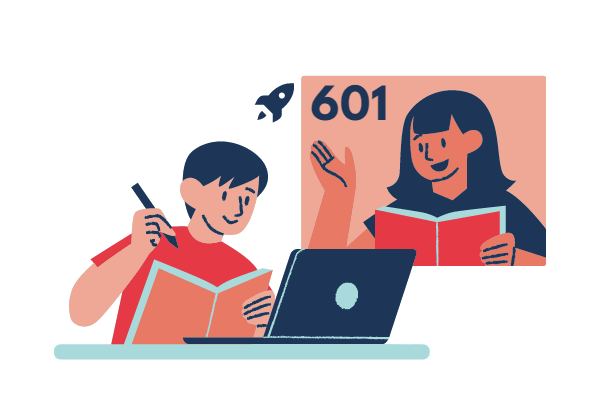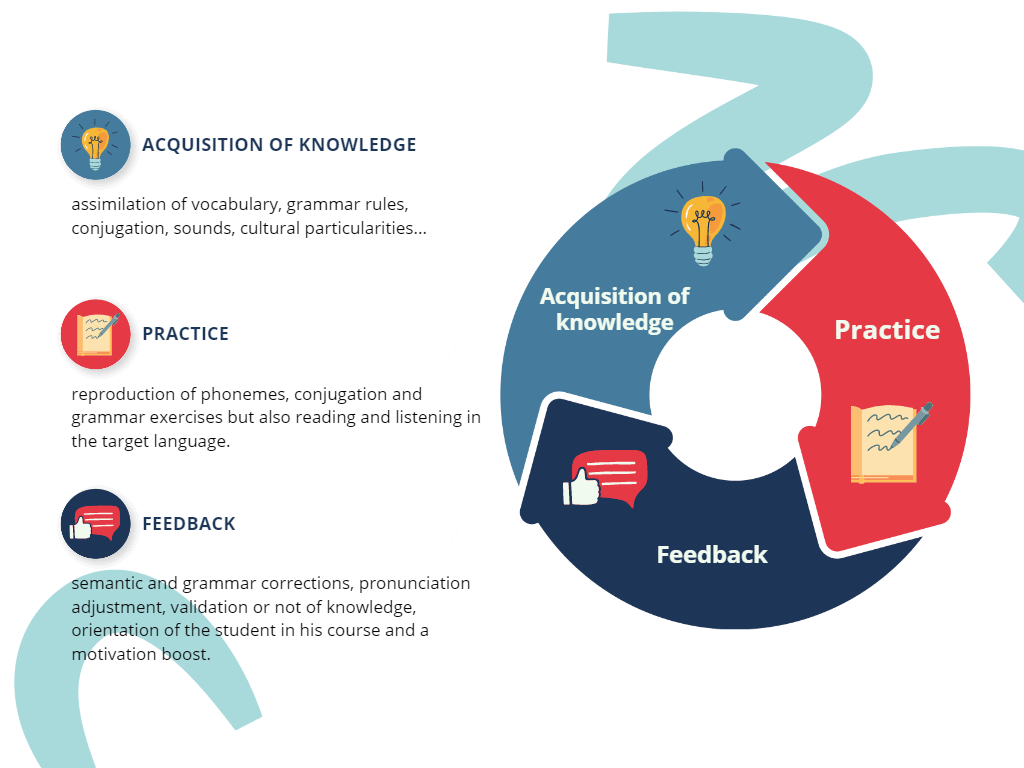To make language learning more effective, sociable and accessible.
By rethinking the role of the teacher with today’s technologies.

Learning a language in 2022 should be easy, the range of tools at our disposal has never been so large. Everything is there: a large choice of applications (Duolingo, Babbel, Buusuu…) very accessible or even free, platforms to connect teachers from all over the world (iTalki, Preply…), exchange platforms (Tandem, HelloTalk…), and thousands of free contents on Youtube, Instagram & co. You can also more and more easily create an environment in the language you want to learn with Netflix series and podcasts.
Today, anyone with an internet connection can create an individualized program and start learning a language with tools that would make the student of the 2000s dream.
So why do we always have so much trouble learning a new language?
If the tools for learning a language are more accessible, we still have much trouble learning. Despite what we might think, there are no studies to date that clearly show that you learn a language faster online than in a classroom.
In fact, if you ask your bilingual friends how they learned the language, chances are it was in a classroom or a special school. Even after the Covid19 pandemic, 95% of us are still taking face-to-face classes, in groups or with a private teacher.
Why do we learn better in the classroom?
Well, let’s face it, the number one reason we fail to learn a language is because we stop learning it… After how many weeks or days did you stop using Duolingo? That grammar book you bought 5 months ago, where did you put it? As good as the material you use may be, it often fails to act on the first criterion of success in learning a language: your motivatio
Are we more motivated in a classroom?
The answer is yes, and we are also more efficient (some studies at the bottom of the page). This is especially true for those who have more difficulty to stay focused or do not have the right environment to study. Main reasons for that: the role of the teacher, social pressure, regular schedule, frequent interactions between students and teacher, continuous feedback…
Does this mean we all have to go back to school to learn a language?
As an adult, it is often quite complicated, there is often not enough time to go to an institute, in many places these institutes or academies are simply not available, and finally the possibility to participate in this kind of course is only accessible to a minority because of the important budget that must be committed.
So how do we recreate the conditions for success in online classes?
It is not a matter of duplicating what we do in the classroom on an online model but of rethinking the classroom and its organization.
The classroom must first serve the efficiency of knowledge transmission, and an efficient classroom model for the study of biology is not the same as for the learning of a modern language.
There are 3 phases to learning a language

There are 3 phases to learning a language

You may have experienced classes where the teacher spends 30 minutes reciting a list of irregular verbs, or that group class where he makes each student repeat the same exercise. It is as frustrating for the student as it is for the teacher.
There are much more fun (and free!) ways to learn the basics, whether it’s with an application like Duolingo to get started, or interactive online grammar exercises. Today these resources are available to everyone.
The teacher must not be forgotten, but must find his place where he is most useful: as a guide and supervisor. The teacher will then be able to analyze the student’s difficulties, validate or not the acquired knowledge, direct the student towards the right material and above all give him confidence and motivate him in his learning.
Thanks to the teacher, the student is able to know where he stands in his learning, he is aware of his progress and gaps, and knows how to reach a defined objective. The aim is to give each of these phases the most effective tools to make learning smooth and enjoyable.
In this way, with the right approach, we can reduce the time needed by a teacher to about 20 to 30% of the total time spent learning the language and make learning a language much more affordable.
How can the school give freedom to its students while imposing a common base?
One of the well-known problems of the classroom model is respecting the learning pace of each student. In a group course, pedagogical differentiation is difficult and one regularly finds oneself with students of different levels in the same group, even if there are groups of levels.
By differentiating the phases of knowledge acquisition, practice and feedback, it is possible to offer an effective individual experience.
During the feedback phase, the teacher can refer the student to the necessary reminders, decide to simplify certain exercises, give more or less freedom to the student and finally adapt the time needed for learning. It is the knowledge acquisition and practice phases that should be most adaptable to the student’s learning, not the feedback time, which could be the same for each student.
If the experience is individualised in this way, it is still social, and the mutual help between more experienced students and those with more difficulties must be encouraged. The latter can then benefit from the help of their classmates and the more experienced ones can reinforce their knowledge by explaining it (Feyman’s technique).
Thus, even if the goal for the group is the same, the time and the tools to reach it vary, giving everyone a real chance to reach their goal without penalizing (by charging more for lessons) the less academic students.
How can the school give freedom to its students while imposing a common base?
Motivation is at the heart of our school. Some students have strong intrinsic motivations such as an upcoming transfer to France, a university exchange… but even with these strong motivations, we often note a decrease in motivation week after week.
We have built a model on the key factors of motivation:
- Stimulate interest and remind students of their objectives every week
- Social environment: learning in a group also means evolving with the group, social pressure plays an important role (attendance at classes in particular).
- Gamification: make learning a language fun (increased interaction, points and levels system)
- Role of the guiding teacher: ideally the student is followed by the same teacher who will guide and motivate him/her towards his/her objectives
- Frustration control: consider mistakes as a factor of progress, and especially anticipate frustrations (learning a language is not an easy thing!)
- Breakdown of objectives over time
- Make the results concrete and activable: making your progress visible is surely the greatest source of motivation. If after 6 months of French you still haven’t managed to practice in a real life situation, you’ve already dropped out.
Why 601?
It takes an average of 600 words to participate in a meaningful conversation, which is equivalent to the beginning of level A2. These 600 words and the basic grammar rules, once planned, represent a largely attainable goal for everyone.
601 because we focus on the basics without wasting time (no crazy vocabulary lists or learning the alphabet in the first class), we focus on the most important structures to unlock a conversation as quickly as possible.
601 because we want to unite our teachers around a common goal
601 because we go further than these 600 words
601 to remind everyone that it is possible
Want to join the aventure ?
Sources:
